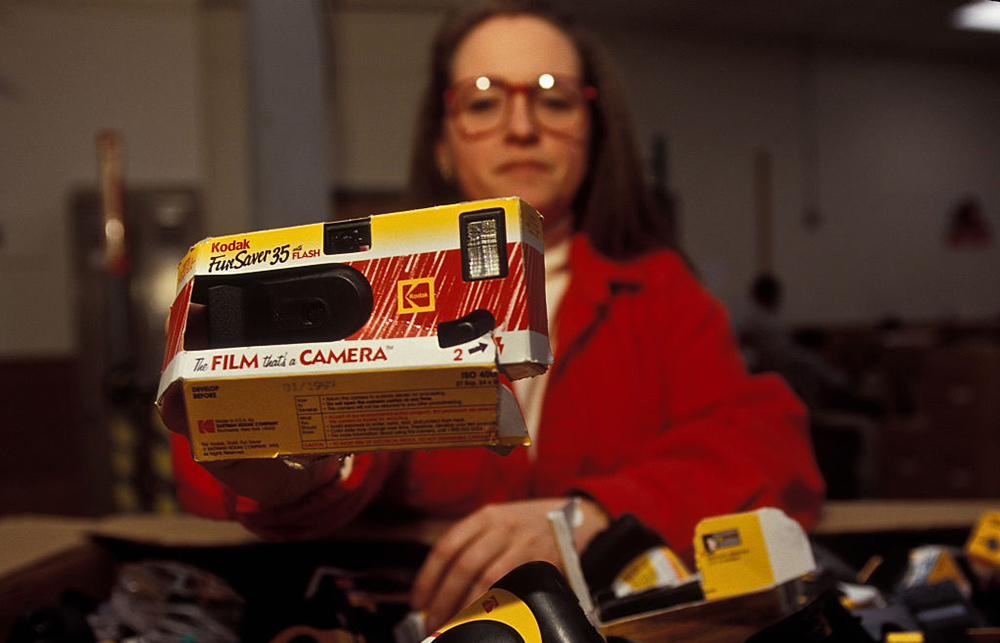傳奇相機(jī)制造商伊士曼柯達(dá)公司(Eastman Kodak)在周二宣布了一條驚人的消息:美國政府將向其提供高達(dá)7.65億美元的貸款,,用于仿制藥生產(chǎn),以強(qiáng)化美國本土供應(yīng)鏈,,從而應(yīng)對新冠病毒大流行,。
柯達(dá)的首席執(zhí)行官吉姆?科倫扎向《華爾街日報(bào)》表示,預(yù)計(jì)制藥業(yè)務(wù)最終將占其業(yè)務(wù)的30%至40%,。
在柯達(dá)宣布獲得政府貸款后,,該公司的股價(jià)暴漲了318.14%。周二收盤時(shí),,該公司的市值從1.15億美元升至3.47億美元,,創(chuàng)下了該公司有史以來的最佳單日漲幅。
從膠卷生產(chǎn)和醫(yī)療成像業(yè)務(wù)轉(zhuǎn)向制藥領(lǐng)域,,這一讓人匪夷所思的轉(zhuǎn)變其實(shí)并不新鮮,。柯達(dá)不過是走上了昔日競爭對手日本富士膠片控股公司(Fujifilm Holdings Corp.)的老路,。

在20世紀(jì)的大部分時(shí)間里,柯達(dá)和富士幾乎壟斷了膠片攝影行業(yè),,但到目前為止,,事實(shí)證明富士比柯達(dá)更善于“自我改造”。
1975年,,一位柯達(dá)工程師發(fā)明了第一臺數(shù)碼相機(jī),,但公司并沒有意識到這項(xiàng)技術(shù)的潛力。而富士公司則更快地轉(zhuǎn)向數(shù)碼技術(shù),,在1988年推出了世界上第一臺便攜式數(shù)碼相機(jī),,并且讓這家日本公司更快地?cái)[脫了膠片業(yè)務(wù)的局限。
同樣在制藥領(lǐng)域,,富士也比柯達(dá)領(lǐng)先了好幾步,。到2019年,醫(yī)療保健和材料解決方案收入占富士總收入的43%,,該公司還計(jì)劃在未來幾年將醫(yī)療保健部門的銷售額翻一番,。
該公司早在1986年就收購了一家醫(yī)療影像診斷公司。此后,,富士又收購了幾家生物制藥公司,,將自己打造成了醫(yī)療設(shè)備和藥品的主要生產(chǎn)商,。
2006年,,它收購了制藥公司富士膠片富山化學(xué)公司(Fujifilm Toyama Chemical),后者研發(fā)出了抗病毒藥物法匹拉韋(Avigan),是新冠病毒治療藥物研發(fā)的早期競爭者(不過,,本月初的臨床研究尚無定論,,這削弱了人們對法匹拉韋研發(fā)的熱情)。
周一,,富士在2013年收購的生物技術(shù)科技公司Fujifilm Diosynth Biotenologies宣布,,作為美國政府新冠病毒疫苗研發(fā)計(jì)劃“空間機(jī)站行動(dòng)”(Operation Warp Speed)的參與者,其得克薩斯州工廠將支持生產(chǎn)冠狀病毒候選疫苗,。
曾經(jīng)幾十年在美國相機(jī)和膠卷市場上占據(jù)主導(dǎo)地位的柯達(dá),,在行業(yè)中掙扎數(shù)年后,于2012年申請破產(chǎn)保護(hù),。2013年走出破產(chǎn)困境后,,該公司更名為一家專注于商業(yè)印刷和商業(yè)成像業(yè)務(wù)的科技公司。
這兩家公司均由影像業(yè)轉(zhuǎn)型制藥業(yè)并非巧合,??逻_(dá)和富士都表示,它們先前生產(chǎn)膠卷以及各類影像產(chǎn)品的經(jīng)驗(yàn)完全適用于藥品生產(chǎn),。
在接受《華爾街日報(bào)》采訪時(shí),,科倫扎表示,柯達(dá)“在化工品,、先進(jìn)材料的制備上有著相當(dāng)悠久的歷史”,,并表示公司現(xiàn)有的基礎(chǔ)設(shè)施可以讓柯達(dá)制藥“迅速投入生產(chǎn)”。
早在進(jìn)軍制藥業(yè)數(shù)年前,,富士就發(fā)起過名為“全面醫(yī)療保健公司”的活動(dòng),。而現(xiàn)在富士堅(jiān)稱,其制藥業(yè)的成功與其影像業(yè)的過往經(jīng)驗(yàn)密不可分,,并在官方網(wǎng)站表示,,公司研發(fā)藥物時(shí)專門采用了“富士由來已久的獨(dú)家膠片制作技術(shù)”。
白宮顧問彼得?納瓦羅表示,,此次疫情暴露出了美國“對外國基本藥物供應(yīng)的過度依賴”,,并稱此次柯達(dá)的轉(zhuǎn)型是“美國向自主制藥邁進(jìn)的一大步”。
目前,,中國是全世界最大的藥品原料供應(yīng)國,,可生產(chǎn)大量用于藥品制備的活性成分,美國從中國進(jìn)口的原料近年來也有所增加,。(財(cái)富中文網(wǎng))
編譯:劉心辰,、杜心邈
傳奇相機(jī)制造商伊士曼柯達(dá)公司(Eastman Kodak)在周二宣布了一條驚人的消息:美國政府將向其提供高達(dá)7.65億美元的貸款,用于仿制藥生產(chǎn),,以強(qiáng)化美國本土供應(yīng)鏈,,從而應(yīng)對新冠病毒大流行,。
柯達(dá)的首席執(zhí)行官吉姆?科倫扎向《華爾街日報(bào)》表示,預(yù)計(jì)制藥業(yè)務(wù)最終將占其業(yè)務(wù)的30%至40%,。
在柯達(dá)宣布獲得政府貸款后,,該公司的股價(jià)暴漲了318.14%。周二收盤時(shí),,該公司的市值從1.15億美元升至3.47億美元,,創(chuàng)下了該公司有史以來的最佳單日漲幅。
從膠卷生產(chǎn)和醫(yī)療成像業(yè)務(wù)轉(zhuǎn)向制藥領(lǐng)域,,這一讓人匪夷所思的轉(zhuǎn)變其實(shí)并不新鮮,??逻_(dá)不過是走上了昔日競爭對手日本富士膠片控股公司(Fujifilm Holdings Corp.)的老路,。
在20世紀(jì)的大部分時(shí)間里,,柯達(dá)和富士幾乎壟斷了膠片攝影行業(yè),,但到目前為止,,事實(shí)證明富士比柯達(dá)更善于“自我改造”,。
1975年,,一位柯達(dá)工程師發(fā)明了第一臺數(shù)碼相機(jī),,但公司并沒有意識到這項(xiàng)技術(shù)的潛力,。而富士公司則更快地轉(zhuǎn)向數(shù)碼技術(shù),,在1988年推出了世界上第一臺便攜式數(shù)碼相機(jī),并且讓這家日本公司更快地?cái)[脫了膠片業(yè)務(wù)的局限,。
同樣在制藥領(lǐng)域,,富士也比柯達(dá)領(lǐng)先了好幾步。到2019年,,醫(yī)療保健和材料解決方案收入占富士總收入的43%,,該公司還計(jì)劃在未來幾年將醫(yī)療保健部門的銷售額翻一番。
該公司早在1986年就收購了一家醫(yī)療影像診斷公司,。此后,,富士又收購了幾家生物制藥公司,將自己打造成了醫(yī)療設(shè)備和藥品的主要生產(chǎn)商,。
2006年,,它收購了制藥公司富士膠片富山化學(xué)公司(Fujifilm Toyama Chemical),后者研發(fā)出了抗病毒藥物法匹拉韋(Avigan),,是新冠病毒治療藥物研發(fā)的早期競爭者(不過,,本月初的臨床研究尚無定論,這削弱了人們對法匹拉韋研發(fā)的熱情),。
周一,,富士在2013年收購的生物技術(shù)科技公司Fujifilm Diosynth Biotenologies宣布,作為美國政府新冠病毒疫苗研發(fā)計(jì)劃“空間機(jī)站行動(dòng)”(Operation Warp Speed)的參與者,,其得克薩斯州工廠將支持生產(chǎn)冠狀病毒候選疫苗,。
曾經(jīng)幾十年在美國相機(jī)和膠卷市場上占據(jù)主導(dǎo)地位的柯達(dá),,在行業(yè)中掙扎數(shù)年后,于2012年申請破產(chǎn)保護(hù),。2013年走出破產(chǎn)困境后,,該公司更名為一家專注于商業(yè)印刷和商業(yè)成像業(yè)務(wù)的科技公司,。
這兩家公司均由影像業(yè)轉(zhuǎn)型制藥業(yè)并非巧合,。柯達(dá)和富士都表示,,它們先前生產(chǎn)膠卷以及各類影像產(chǎn)品的經(jīng)驗(yàn)完全適用于藥品生產(chǎn),。
在接受《華爾街日報(bào)》采訪時(shí),科倫扎表示,,柯達(dá)“在化工品,、先進(jìn)材料的制備上有著相當(dāng)悠久的歷史”,并表示公司現(xiàn)有的基礎(chǔ)設(shè)施可以讓柯達(dá)制藥“迅速投入生產(chǎn)”,。
早在進(jìn)軍制藥業(yè)數(shù)年前,,富士就發(fā)起過名為“全面醫(yī)療保健公司”的活動(dòng)。而現(xiàn)在富士堅(jiān)稱,,其制藥業(yè)的成功與其影像業(yè)的過往經(jīng)驗(yàn)密不可分,,并在官方網(wǎng)站表示,公司研發(fā)藥物時(shí)專門采用了“富士由來已久的獨(dú)家膠片制作技術(shù)”,。
白宮顧問彼得?納瓦羅表示,,此次疫情暴露出了美國“對外國基本藥物供應(yīng)的過度依賴”,并稱此次柯達(dá)的轉(zhuǎn)型是“美國向自主制藥邁進(jìn)的一大步”,。
目前,,中國是全世界最大的藥品原料供應(yīng)國,可生產(chǎn)大量用于藥品制備的活性成分,,美國從中國進(jìn)口的原料近年來也有所增加,。(財(cái)富中文網(wǎng))
編譯:劉心辰、杜心邈
The U.S. government is loaning legendary camera maker Eastman Kodak $765 million to start manufacturing pharmaceutical products in a bid to increase U.S. self-sufficiency in response to the coronavirus pandemic, the company announced Tuesday.
Kodak chief executive Jim Continenza told the Wall Street Journal that pharmaceutical ingredient production will eventually make up 30% to 40% of Kodak’s business.
Shares in Kodak more than tripled after the government loan announcement, pushing the firm’s market value from $115 million to $347 million by close on Tuesday, the stock’s best performance day ever.
In its leap from film and imaging to pharmaceutical production, Kodak follows the path of its erstwhile rival, Japan’s Fujifilm Holdings Corp. The two companies formed a near-duopoly on film photography for much of the 20th century, but Fujifilm has so far proved far more adept at reinventing itself than its American counterpart.
A Kodak engineer invented the first digital camera in 1975, but the company failed to recognize the technology’s potential. Fujifilm was quicker to pivot to digital, introducing the world’s first digital portable camera in 1988, and the Japanese firm was faster to diversify away from photographic film.
Fujifilm is also several steps ahead of Kodak in the pharmaceutical realm. Health care and material solutions made up 43% of Fujifilm’s total revenue in 2019, and the company aims to double its health care sector sales over the next few years.
The company acquired a medical diagnostic imaging company as early as 1986. Since then, Fujifilm has acquired several more pharmaceutical and biotechnology companies and fashioned itself into a major producer of medical equipment and drugs.
In 2006, it bought the company that became the drugmaker Fujifilm Toyama Chemical, which developed the antiviral Avigan, an early contender in the race to develop a COVID-19 treatment. (Inconclusive clinical studies earlier this month have dampened enthusiasm for Avigan, however.)
Fujifilm Diosynth Biotechnologies, a pharmaceutical manufacturer that Fujifilm acquired in 2013, announced on Monday that its Texas site will support production of a coronavirus vaccine candidate as part of Operation Warp Speed, a U.S. government COVID-19 vaccine development program.
Kodak, which dominated cameras and photographic film in the U.S. for decades, filed for bankruptcy protection in 2012 after years of struggling to adapt to changes in the industry. It rebranded as a technology company focused on printing and imaging for businesses after coming out of bankruptcy in 2013.
That both firms have pivoted from film to pharmaceuticals is not coincidence. Each firm says its experience manufacturing film and other photography products lends itself to drugmaking.
Continenza told the Wall Street Journal that Kodak has a “l(fā)ong, long history in chemical and advanced materials” and said the company’s existing infrastructure will enable Kodak Pharmaceuticals “to get up and running quickly.”
Fujifilm, which launched its campaign to become a “total health care company” years before Kodak ventured into the space, has linked its history in photography to its success in pharmaceuticals. Fujifilm’s drug development efforts apply “proprietary technologies harnessed through Fujifilm’s long-standing operations in photographic films,” according to its website.
White House adviser Peter Navarro said the pandemic has revealed the U.S. to be “dangerously dependent on foreign supply chains” for essential drugs, and called the Kodak deal “a huge step forward towards American pharmaceutical independence.”
China is currently the world’s largest supplier of pharmaceutical ingredients, the active compounds used to make drugs, and U.S. imports from China have increased in recent years.






